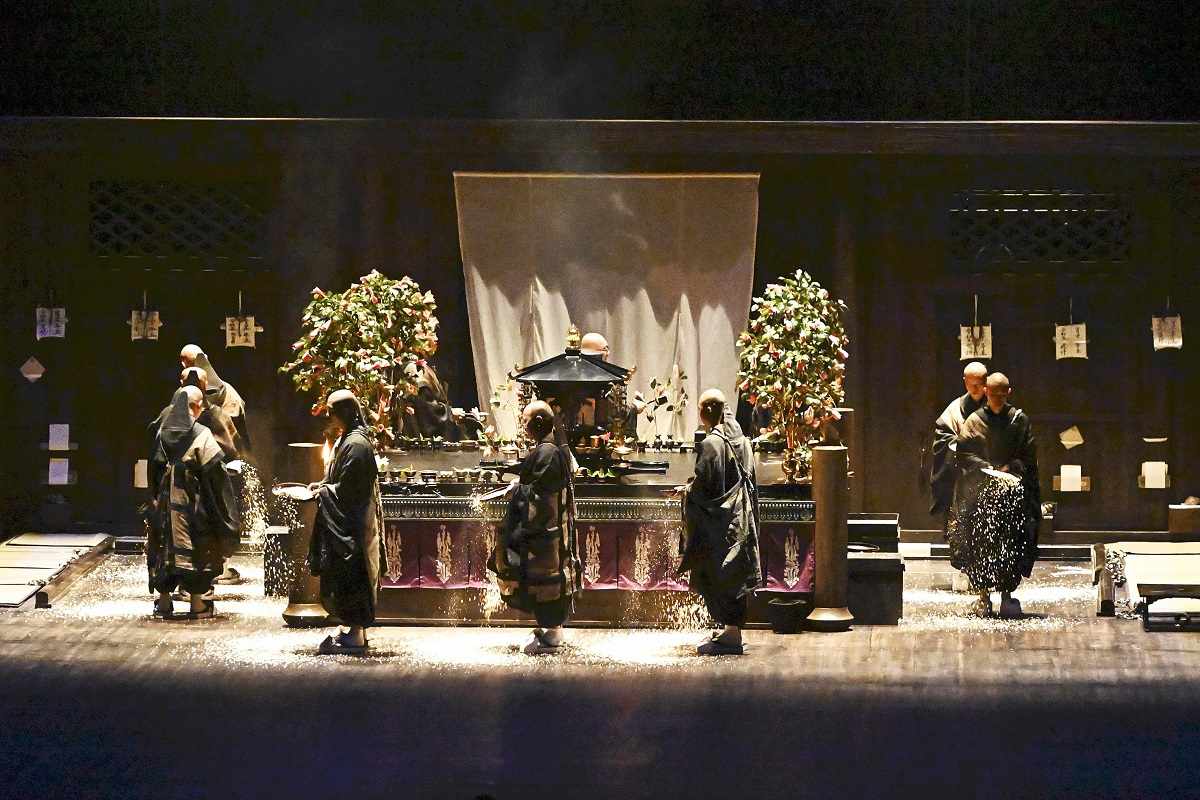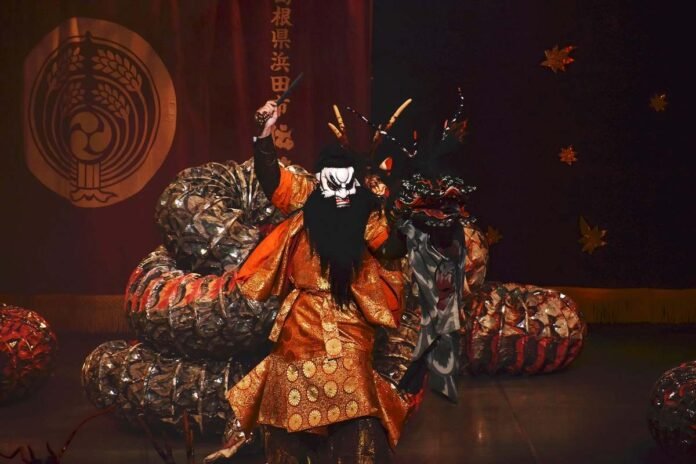A scene from “Orochi” during Iwami Kagura by Kameyama Shachu group in Suita, Osaka Prefecture, on May 7
11:00 JST, June 29, 2023
Kagura, dancing to live music to worship Shinto deities, and shomyo, chanting Buddhist sutras, are gaining attention as a result of live performances held in various cities across the country.
The organizers of these events expect that these religious rituals will become widely known as local cultural traditions and will revitalize different regions. They also hope to promote cultural traditions with the return of foreign visitors following the lifting of COVID-19 travel restrictions.
In Kagura, dancers wear colorful costumes and perform images from mythological folklore to elegant flute playing and drumming. The stories have been passed down for generations in different areas and it is said that there are more than 600 kagura groups throughout the country.
Kameyama Shachu, a kagura group from Hamada, Shimane Prefecture, performed at the May Theater in Suita, Osaka Prefecture last month, their first performance in the prefecture. They danced Iwami Kagura from the Iwami area of the prefecture in a performance accented with smoke and confetti. The program included ‘Orochi’, which depicts the extermination of a giant snake. When the giant snake coiled onto the stage, the audience applauded.
The event was organized by Ikuo Takahashi, 71, who operates a live music club in Osaka Prefecture. A few years ago, Takahashi became fascinated by the group’s beautiful costumes and performance style with a modern interpretation of kagura.
“This is a beautiful art form that takes us to the world of antiquity. It’s a shame if people don’t know this,” Takahashi said. “I believe it will be fun for visitors from abroad and will even encourage them to visit the Iwami area.”
In Hiroshima and Shimane prefectures, where many kagura groups are active, such performances have been shown not only in shrines but also in local halls.
According to officials in Akitakata City, Hiroshima Prefecture, local kagura groups formed an association about a decade ago to perform outside the prefecture to promote local tourism and attract new fans, despite the declining number of artists like due to population density. aging and decay.
The city government and others began holding kagura performances in Tokyo before holding their first in the Kansai region last year.
On May 13 this year, Hiroshima Kagura was performed at Mielparque Hall in Osaka. “I hope [performing kagura outside the prefecture] will help attract new residents to the area and lead to more people performing and passing on the traditions to future generations,” said the head of the city’s trade, industry and tourism department.

The Shunie shomyo performed by Todaiji Temple monks at the Festival Hall on May 13
Shomyo has sometimes been performed in venues since it gained attention as a form of Buddhist music around 1980. The Hieizan Enryakuji Temple in Otsu performed at the National Theater in Tokyo in February this year.
On May 13, Todaiji Temple in Nara held a shomyo performance at the Festival Hall in Osaka. Shomyo was part of the temple’s sacred Shunie ceremony, or Omizutori, held at Nigatsudo Hall since the Nara period (710-784). It was the first time in fourteen years that shomyo was performed outside the temple to mark the 1,250th anniversary of the death of the first head monk, Roben, also known as Ryoben. Eleven monks performed on a stage decorated with a reproduced interior of the Nigatsudo Hall.
“Shomyo is just as distinctive as opera. It differs from Western vocalization because it uses the natural voice,” said the representative of the foundation that organized the event.
“Shomyo contains prayer that I hope will help people overcome what is currently going on in the world, such as the pandemic and the invasion of Ukraine,” said Koei Hashimura, the temple’s head monk.
Kenta Yamamoto, a professor specializing in economic geography at Kokugakuin University, explained the recent series of kagura and shomyo performances, saying, “Many people seem to be more interested in traditional Japanese culture. People from abroad are also interested. I think [the performances] will be accepted in different ways as part of traditional Japanese culture.”



